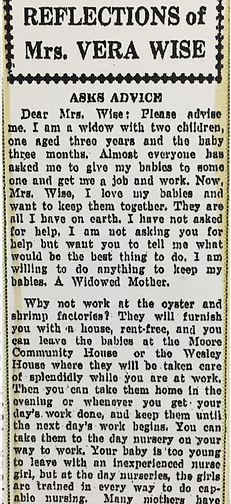Our History
Moore Community House's history stretches back more than a century, but while we have adapted to the changing world around us, we remain committed to our mission of serving families.
Moore Community House was founded in Biloxi in 1924 by the Rev. Waldo W. Moore and his wife, Myrtie. It was a time when east Biloxi was filled with seafood factories that attracted workers from around the world, especially central Europe after World War I. Many came with young children.
In a biography written by Myrtie Moore and provided to MCH by her family, she recalled "the reason for the community house was so that working mothers would have a nursery in which to leave their children." Myrtie also had a night school for workers as well.
Many children - in this time before child labor laws - also worked at the factories. The plight of these children was captured in a series of images taken in 1911 by the noted photographer Lewis Hine. Working for the National Child Labor Committee, Hine traveled around the country documenting child workers in a variety of trades, including farms, mills and factories. His photos from Biloxi show children as young as five who were working long hours in the seafood canneries. (More than 90 of these images from Mississippi can be viewed online on the Library of Congress website.) Hine's work helped lead to reforms in labor laws that finally prohibited the use of child labor.
Moore Community House was founded in Biloxi in 1924 by the Rev. Waldo W. Moore and his wife, Myrtie. It was a time when east Biloxi was filled with seafood factories that attracted workers from around the world, especially central Europe after World War I. Many came with young children.In a biography written by Myrtie Moore and provided to MCH by her family, she recalled "the reason for the community house was so that working mothers would have a nursery in which to leave their children." Myrtie also had a night school for workers as well.Many children - in this time before child labor laws - also worked at the factories. The plight of these children was captured in a series of images taken in 1911 by the noted photographer Lewis Hine. Working for the National Child Labor Committee, Hine traveled around the country documenting child workers in a variety of trades, including farms, mills and factories. His photos from Biloxi show children as young as five who were working long hours in the seafood canneries. (More than 90 of these images from Mississippi can be viewed online on the Library of Congress website.) Hine's work helped lead to reforms in labor laws that finally prohibited the use of child labor.
In the 1920s and 1930s, the community house on Davis Avenue was a busy place. In 1931, Daily Herald advice columnist Mrs. Vera Wise told a widow with two children to look for work at the oyster and shrimp factories, which will provide her with a house, "and you can leave the babies at Moore Community house or the Wesley house, where they will be taken care of splendidly while you are at work ... Many mothers have raised their children this way" ("Reflections of Mrs. Vera Wise," The Daily Herald, Dec. 3, 1931 - see photo at left. Thank you to the Biloxi Library for their help with historical articles and information).
A Daily Herald article from the following year reports that 13 clubs met regularly at Moore: "the sewing school, three girl scout troops, the primary children's story hour, service clubs for boys in which they are taught woodcraft and supervised athletics, a boy scout troop; also several clubs for women they being partly for recreation and partly for aid in sewing." There was a small circulating library, and the community house sponsored and supplied seeds for family garden plots. "A large vacant lot adjoining was lent to them, which 22 families have transformed into a model garden, each being allotted an individual plot" (The Daily Herald, Nov. 26, 1932)
It seems that the nursery program had to be canceled for economic reasons during this time at the height of the Great Depression - the 1932 article says the community house had "in more prosperous times, a day nursery. " But in January 1936, a WPA-supervised nursery opened at Moore, serving an average of 30 "little tots, age two to four years." It was expected to remain open until the end of the summer of 1937 (The Daily Herald, May 12, 1936).
The nursery at Moore was one of many Works Progress Administration-staffed nurseries for low-income children started through an Emergency Education Program begun in October 1933. Just as today, it both created jobs - allowing the WPA to hire teachers and staff - and allowed parents the opportunity to work themselves.
Rev. Waldo Moore died in 1944; in his obituary, it was noted "the Moore Memorial Community House ... continues to be a lighthouse for multitudes along the highways of life."
In 1959, according to an article about Moore on its 35th anniversary, Moore Community House had a kindergarten class, taught by Mrs. Ruth Buck, with 32 children, "one of the few accredited kindergartens in Biloxi." About 250 children took part in activities at Moore each week, including five handicraft classes, three library classes, supervised playground activities, and Brownie and Girl Scouts (Dec. 10, 1959).
Waldo W. Moore

Myrtie Moore

"Manuel, the young shrimp-picker, five years old, and a mountain of child-labor oyster shells behind him. He worked last year. Understands not a word of English. Dunbar, Lopez, Dukate Company. Location: Biloxi, Mississippi."
Lewis Hine, February 1911




